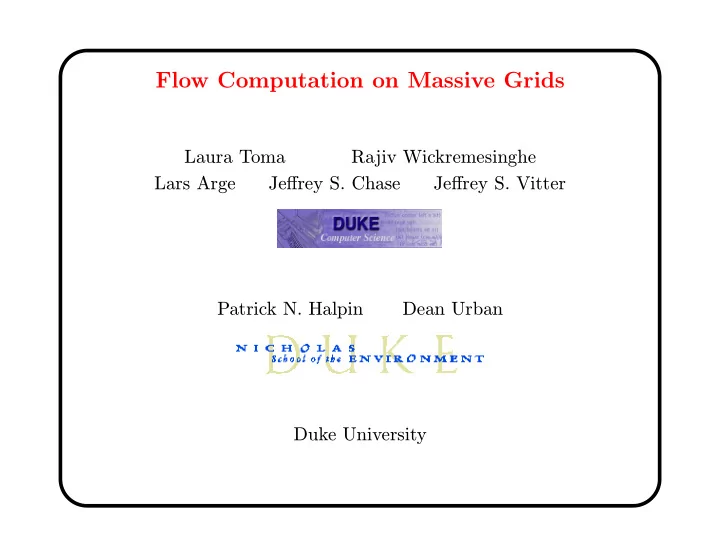

Flow Computation on Massive Grids Laura Toma Rajiv Wickremesinghe Lars Arge Jeffrey S. Chase Jeffrey S. Vitter Patrick N. Halpin Dean Urban Duke University
Flow Computation on Massive Grids Flow Modeling on Terrains ✫ Terrain represented as a grid ✫ Flow modeled by two basic attributes Flow direction: The direction water flows at a point in the • grid Flow accumulation value: Total amount of water which flows • through a point in the grid ✫ Objective: Compute flow directions and flow accumulation values for the entire grid Flow routing • Flow accumulation • L. Toma, R. Wickremesinghe, L. Arge, J. Chase, J. Vitter, P. Halpin, D. Urban 2
Flow Computation on Massive Grids Flow Routing 3 2 4 3 2 4 ✫ Water flows downhill. 7 5 8 7 5 8 7 1 9 7 1 9 ✫ Compute flow directions by inspecting 8 neighbor points. ✫ Flat areas: plateaus and sinks. L. Toma, R. Wickremesinghe, L. Arge, J. Chase, J. Vitter, P. Halpin, D. Urban 3
Flow Computation on Massive Grids Flow Accumulation ✫ Water flows following the flow directions ✫ Compute the total amount of flow through each grid point • Initially one unit of water on each grid point • Every point distributes water to the neighbors pointed to by its flow direction(s) L. Toma, R. Wickremesinghe, L. Arge, J. Chase, J. Vitter, P. Halpin, D. Urban 4
Flow Computation on Massive Grids Applications ✫ Watersheds, drainage network ✫ Erosion, infiltration, drainage, solar radiation distribution, sediment transport, vegetation structure, species diversity L. Toma, R. Wickremesinghe, L. Arge, J. Chase, J. Vitter, P. Halpin, D. Urban 5
Flow Computation on Massive Grids Massive Data ✫ Massive remote sensing data available • USGS (entire US at 10m resolution) • NASA’s SRTM (whole Earth, 5TB) • LIDAR ✫ Example: Appalachian Mountains (800km × 800km) • at 100m resolution: 500MB • at 30m resolution: 5.5GB • at 10m resolution: 50GB • at 1m resolution: 5TB !! L. Toma, R. Wickremesinghe, L. Arge, J. Chase, J. Vitter, P. Halpin, D. Urban 6
Flow Computation on Massive Grids Scalability to Massive Data ✫ Existing software GRASS r.watershed • ∗ killed after 17 days on a 50MB dataset ArcInfo flowdirection, flowaccumulation • ∗ can handle the 50MB dataset ∗ cannot process files > 2 GB ✫ Current GIS algorithms minimize CPU time ✫ I/O is the bottleneck in computation on massive data! L. Toma, R. Wickremesinghe, L. Arge, J. Chase, J. Vitter, P. Halpin, D. Urban 7
Flow Computation on Massive Grids Our Results: TerraFlow ✫ Collection of theoretical algorithms and practical implementations for flow routing and flow accumulation on massive grids. ✫ Available at http://www.cs.duke.edu/geo*/terraflow/ ✫ Efficient • 2-1000 times faster on massive grids than existing software ✫ Scalable • 1 billion elements! ( > 2GB) ✫ Flexible • different flow models L. Toma, R. Wickremesinghe, L. Arge, J. Chase, J. Vitter, P. Halpin, D. Urban 8
Flow Computation on Massive Grids Outline ✫ The I/O-Model ✫ Flow routing: Previous work and I/O-efficient algorithm ✫ Experimental results ✫ Open problems L. Toma, R. Wickremesinghe, L. Arge, J. Chase, J. Vitter, P. Halpin, D. Urban 9
Flow Computation on Massive Grids Disk Model [Aggarwal & Vitter ’88] N = # of points in the grid D M = # of vertices / edges that fit in memory B = # of vertices / edges per disk block Block I/O ✫ I/O complexity M ✫ Basic bounds • scan( N ) = N B ≪ E • sort( N ) = Θ( N N B log M/B B ) ≪ E P L. Toma, R. Wickremesinghe, L. Arge, J. Chase, J. Vitter, P. Halpin, D. Urban 10
Flow Computation on Massive Grids I/O-Efficient Flow Routing ✫ Flow routing: assign flow direction to every point such that • Flow directions do not induce cycles = ⇒ every point has a flow path to the edge of the terrain Steps: 1. Assign flow directions to all points which have downslope neighbors. 2. Identify flat areas, their boundaries and spill points. 3. Assign flow directions on plateaus. 4. Remove sinks. 5. Assign flow directions to the entire terrain (repeat steps 1-3). L. Toma, R. Wickremesinghe, L. Arge, J. Chase, J. Vitter, P. Halpin, D. Urban 11
Flow Computation on Massive Grids Removing Sinks ✫ Sinks are removed by flooding [Jenson & Domingue ’88] ✫ Flooding fills the terrain up to the steady state level reached when an infinite amount of water is poured onto the terrain and the outside is viewed as a giant ocean. ������������ ������������ ������������ ������������ ������������ ������������ ������������ ������������ ������������ ������������ ������������ ������������ ������������ ������������ ������������ ������������ ��������� ��������� ��������� ��������� ��������� ��������� ��������� ��������� ��������� ��������� ��������� ��������� ��������� ��������� A watershed u is raised to height h by raising every point in u of height lower than h to height h . ✫ Watershed: part of the terrain that flows into the sink. ✫ Partition the terrain into watersheds − → watershed graph L. Toma, R. Wickremesinghe, L. Arge, J. Chase, J. Vitter, P. Halpin, D. Urban 12
Recommend
More recommend